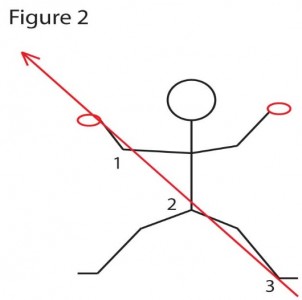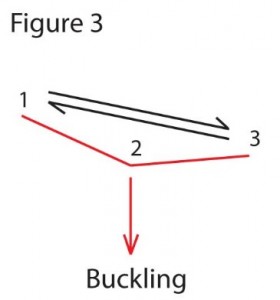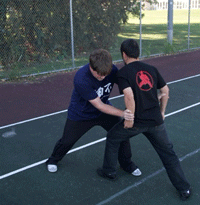By John Upshaw and Levi Sowers
The interaction occurring amongst the various elements of our body are numerous and complex. This is especially true when applied to the movements, and thereof lack of movements, in Chen Style Taijiquan Practical Method. The purpose of this article is to provide a framework that will allow the reader to conceptualize the necessary movements that are congruent with the taiji principals, and inherent to the Practical Method system. The 1, 2, 3 theory of taiji movements will be the framework for describing these internal relationships. We hope that readers will be able to distinguish between what parts of the body moves from what does not move. When that is identified, then a clearer understanding of the lines that are stretched upon within oneself becomes more recognizable.
Within this theory of taiji movements, the numerical representations can be defined as a physiological location that has the capacity to function as a joint. The many joints of the body are present to connect the movements of two or more structures. Proper alignment of these joints and the associated body parts allow/prohibit power to move throughout the body. Moreover, the joint’s functions are to connect two or more structures. The resulting alignment creates lines on the body untimely leading to the generation of power on the opponent. When the numeric representations interact, this is referred to as being “related”. In this theory of taiji movements, the following relationships are allowed to move towards one another (Figure 1):
- 1 can relate to 2
- 2 can relate to 1
- 2 can relate to 3
- 3 can relate to 2
At this point you may be thinking “how does this relate to my body and taiji movements?” Remember, each numeral represents a physiological location within its anatomically correct sequence. For instance, elbow, waist, and feet can be directly inserted into the 1, 2, 3 theory format (Figure 2).
- Elbow can relate to waist.
- Waist can relate to elbow.
- Waist can relate to feet.
- Feet can relate waist.
These sequential relationships exist in several places throughout our body. For example, hand-elbow –shoulder, waist-knee-foot, and elbow-waist-rear foot are few sequential relationships that can be applied to the theory. The purposes of these relationships are to ensure there is no slack, provide a pivot point, maintain structural integrity, maintain space taken from an opponent and develop a line of power that is present in the body (Figure 2).
Another important component of this theory is that of being “unrelated” or a state of “unrelatedness”. Unrelated, from a taiji perspective, can be defined as a relationship in which the nonmoving elements of ones’ physiology are not associated, thus having no effect, with the moving or rotating body part and vice versa. The moving or rotating body part functions independently from the rest of ones’ physiology. This is directly correlated with one of Practical Method’s key principals; one part of the body can perform one function. Therefore, in the 1, 2, 3 theory of taiji movements, the following illustrates the relationship of movements and no movements.
- When 1 relates to 2, then 3 and everything else is unrelated
- When 2 relates to 1, then 3 and everything else is unrelated
- When 2 relates to 3, then 1 and everything else is unrelated
- When 3 relates to 2, then 1 and everything else is unrelated
To make the theory more concrete, we will use a section from the positive circle as an example. Imbedded in our minds is Master Chen Zhonghua’s voice saying, “in with elbow, turn waist, and out with hand”. Hearing this instruction allows me to “connect the dots” in applying the theory. The first thing that is required is to identify the 1, 2, and 3 physiological locations, out of a multitude of combinations. For the positive circle coming in we will use the combination of elbow (1), waist (2), and left rear foot (3). Beginning from right hand extended out while in a half horse stance, elbow relates or goes to waist. During this time waist is the anchor point and foot is unrelated. Then waist goes to left rear foot. When this occurs, the foot is the anchor point and elbow is unrelated. Within this small sequence of movements is a microcosm that can be applied throughout the entire yilu. However, we would recommend beginning with the foundations and perhaps a section of individual postures from the yilu, erlu, and even sword forms.
We previously placed much emphasis on how movements are related in functional manners. We will now shift our focus to movements that are related in dysfunctional manners that compromise the physiology’s structural integrity. Within the theory, the following relationships are prohibited to move toward one another (figure 3):
- 1 can not relate to 3
- 3 can not relate to 1
It is important to note that moving away is allowed as long as one of those points is fixed. In both of the relationships mentioned above, 2 is pushed out causing the structure to buckle (Figure 3). Buckling from a taiji perspective is when a structure collapses from the inside out. Another Practical Method principal, “the inside stays on the inside and the outside stays on the outside”, is directly related to this dynamic of compromised structural integrity. Please refer to the clip below:
When Levi, on the left, is issued energy from Master Chen Zhonghua, his structure buckles. Applying the 1, 2, 3 theory, the following illustrates what happens;
- 1 is head
- 2 is waist
- 3 is feet
Levi’s head (1) relates to his feet (3) causing him to buckle. If you watch closely you will see Levi’s waist (2) leave the inside and move to the outside until his rear foot makes adjustments. It is clear that Levi buckled under Master Chen’s power and structural integrity.
The purpose of this article was to present the 1, 2, 3 Theory of Taiji Movements. It is our hope that readers are better able to understand, identify, and implement this framework of taiji movements within their practice/training regimen. With adherence to these relational principles, we hypothesize taiji practitioners will see a series of changes including: a reduction in slack, increase ability to maintain space taken from an opponent, increased structural integrity, and enhance one’s ability to generate power on the opponent. Ultimately, with continued practice and adherence to these principles, it gives the practitioner an option to be the buckler or the one prone to being buckled…the choice is yours.







{ 8 comments… read them below or add one }
This was a discussion between a few of us:
Bruce Schaub
Thanks for taking the time to write the article John. I have to admit my beginneryness is causing me to struggle with it a bit but I’m working on understanding it better. Very good article, difficult content. I think i’m confused in the sense that ultimately it seems we want to have a relationship between 1 and 3, say if 1 and 3 are hand and foot for example. I have heard Master Chen say before that at the highest level you issue from your foot and nothing in between “competes” or essentially there is an unimpeded path from hand to foot, but there is a step by step procedure for learning that, and you can’t just skip the middle steps and expect to just start issuing directly from the foot, I think if I recall correctly Hong and Feng were the only ones that had reached that level. Not sure if what i’m saying makes any sense, but just wanted to try to give some feedback…although I dont’ know if it will be helpful at all… Thanks again.
Bruce Schaub
I guess to try to put a finer point on what I find confusing. I think I understand it in terms of the overall relationship and sequence but I find the terminology of “unrelated” difficult, it seems there must be a relationship between 1 and 3, so they are “related” but not directly related, but if they are wholly unrelated in the common sense of that word, there is no connection, separation, stretch etc…? am I wrong or can anyone help me get a clearer understanding?
Hugo Ramiro
We have to use Shifu’s definitions.
Hugo Ramiro
Our definitions are usually wrong.
Hugo Ramiro
The related/unrelated one is difficult, I think, also because it flip flops – it’s relative.
Hugo Ramiro
So forget all the implications and take the simplest form.
Hugo Ramiro
The story that master chen told us once involved a rock.
Hugo Ramiro
If you pick up a rock, a nice big round one, it is “not 1”, it is not whole. It is without relationship.
Hugo Ramiro
But if you break the rock into two pieces, suddenly it is “not 2”. It is THREE, and it is three because now it has a relationship to itself.
Hugo Ramiro
And because of that, it is now “1”.
Hugo Ramiro
Get it??!?!
Bruce Schaub
Right thanks, I know a lot of terminology has specialized meaning, and many of the most confusing things are “taiji contradictions” such as training isolation of movements to develop a specific type of connectedness……
John Upshaw
Thanks Bruce. One of the drills Shifu had us do was to stand with back against the wall and the partner would push on the chest of the other…this puts the legs, waist, back and shoulders in a position of being unrelated…the person with the back against the does a positive or negative circles…or combination of such to remove the hands of the opponents. When doing so, if those other parts start to relate…I got stuck…energy is attracted to movements…so the contact point is on my chest…if my body is unrelated, then when I do the circles I can easily remove their arms.
Bruce Schaub
haha no i dont really get the rock, but I like it alot !!!
Bruce Schaub
thanks John, so unrelated in the sense it is “a pure move” completely isolated from any other involvment of other body parts …I get that …thanks…
Hugo Ramiro
So maybe we can have a basic sense of “unrelated”: unrelated: able to function as a team without team members invading each other’s positions.
Hugo Ramiro
(just in this context we are discussing now)
John Upshaw
Gears in a machine are always interconnected…yet the is a choice to turn them on or off…they act independently and one at a time…
Bruce Schaub
right right, I got you Hugo, like the army men fighting on the front line that their job is just “hold the line” the archers bhind them can’t drop their bows and go join the front line because they have teir own unrelated task…but there is an overall coordinated relationship, but each has his own specific job
This is good material…
Hugo Ramiro
Gears a good example as always, they all have power that is unrelated, but the relationship between the gears (proper cogs etc) allows for a transfer of power (that is unrelated).
Bruce Schaub
right John, I see, really like the gear analogy because they are interconnected yet each moves independantlty at the same time, independant yet connected
Bruce Schaub
thanks guys
Hugo Ramiro
And John’s example of the partner drill is a good one too, because now we are talking about our complex human body.
Hugo Ramiro
It is easy to imagine how staying relaxed up against the wall and using the arms has a type of (taiji) pwoer and all is good…
Hugo Ramiro
but then…
Hugo Ramiro
if we try to push our foot against the floor we mess it all up and get tuck because we become DIRECTLY related.
Hugo Ramiro
Indirect relationship only – no eye contact!!
Bruce Schaub
yes that’s a great example… Master Chen calls that “clarity” or your moves are “clear” also “a pure move”
John Upshaw
Shifu had us do the same drill…but without the wall behind us…much more difficult to execute…
conversation continued…
Xavier Santiago
My personal experience when pushinf with non-taiji people or taiji people from another style is that a lot of the moves they make are tossing moves and I do that less than them due to Practical Method training. I still have light years of practice to go, however I notice how I have progressed compared to non PM people who not only have a hard time pushing me, but they can’t figure out what I am doing. The “no strength but all qi” crowd accuse me if using to much force when it is they that end up using too much force when their ni force seems to not work and that is when I get them easily. The martial arts crowd says things like, “nice judo or wrestling techniques.” They can’t believe its Taiji.
Hi everybody!
I don’t quite like : “then 3 & everything else is unrelated” or “then 1 & everything else is unrelated”! I’m not saying it is wrong. It is right and yet not completely right.
I prefer:
– When 1 relates to 2, 3 is related to 1 thru 2, which means to say if 3 is related to 2, then when 1 relates to 2, 1 is related to 3 thru 2! So the alignment is there. But in most cases our alignment is like the diagram showing buckling! We relate 1 to 3 directly without going thru 2!
My humble understanding is : when elbow(1) moves in towards waist (2); foot (3) is connected to waist(2) thru stretching back kua (mind you, no movement at all) such that there is an alignment formed i.e. 1-2-3 is in alignment.
Someone, pls correct me is my understanding is wrong.
Thanks, John & Levi. It’s still a great article. Hugo, comments, pls.
Thanks for this good article. My understanding is that if 2 is the centre or middle part of both ends (1and 3), 2 cannot move or turn towards 1 and 3. That is why 2 is unrelated to 1 and 3. 2 works as reactional force spot for both 1 and 3. 2 is then empty as so energy can pass through and do not trap in 2 position. As energy is not trapped, energy can flow from 3 to 1 or 1 to 3. That is the relationship between 1 and 3.
I don’t know what I could comment on?
May, thanks for your comments. I think you touched upon the need for clarity in the article’s section on being unrelated…a difficult concept to understand within itself. I like the analogy Bruce used: “army men fighting on the front line that job (function) is just “hold the line”, the archers behind them can’t drop their bows and go join the front line because they have their own unrelated task (function)…but there is an overall coordinated relationship, but each have their own specific job (function).”
Now applying this to what we do, lets look at stepping: 1 head, 2 waist and 3 feet.
First function is out with heel. The heel is pushed out by 2 relating to 3 (expansion). This relationship is moving, taking space, the function. The rest of the body does not move…so we can say the relationship or “function” of 2 and 3 is unrelated, or not effecting, the other relationships or “functions” of the body. Moving does not effect the non-moving…
Thanks for your feedback May. It holds me accountable and pushes me to find clarity…a revision on this section needed.
Respectfully, John
This video may help the discussion.
http://practicalmethod.com/2013/07/primary-and-secondary-movements-online-video-purchase/
Thanks, John & James.